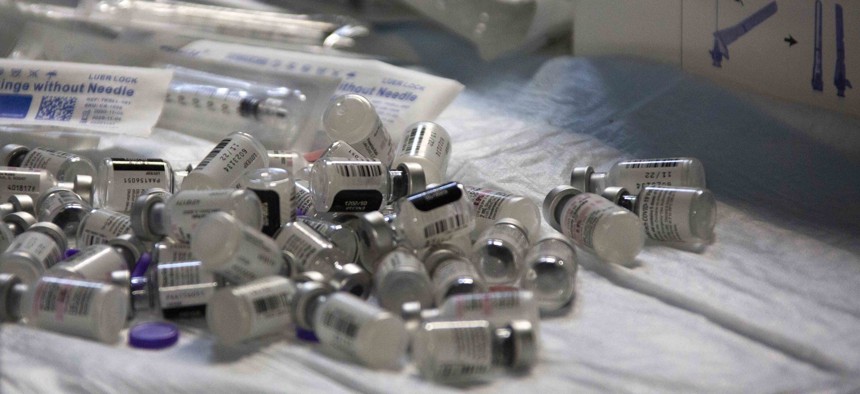
U.S. Marine Corps / Cpl. Leilani Cervantes
The Pentagon Must Prep Now for the Next Pandemic
We must take stock of the myriad ways the U.S. military has helped fight COVID-19—and learn to do even better.
The COVID-19 pandemic is a national-security threat that requires both a domestic and global effort to confront: it has disrupted military operations at all levels and left more than 621,000 people dead in America alone. The U.S. military has proved invaluable in the fight, which is far from over. But it is not too early to begin thinking about how we can better prepare the military to handle a next pandemic.
This effort should start with a proper cataloguing of the unprecedented use of America’s modern military apparatus to battle an unseen enemy on American soil. Our country went on a war footing to combat a disease with the March 13, 2020, declaration of a National Emergency Concerning the Novel Coronavirus Outbreak. In March and April of that first pandemic year, National Guard and Reserve personnel were mobilized to meet the COVID mission.
Almost immediately, DoD faced unanticipated second- and third-order effects. Both components are disproportionately composed of first responders and frontline healthcare workers who regularly serve local communities. In some instances, Guard and Reserve members were pulled from local communities where they were needed in their civilian capacity in order to serve as first responders elsewhere within the same state.
In May 2020, DoD partnered with the Department of Health and Human Services to accelerate vaccine research, development, and distribution. Senior military leaders were enlisted for Operation Warp Speed with the singular purpose of mobilizing the public health industrial base, harnessing the DoD’s robust contracting and logistics infrastructure.
In February of this year, DoD began working with FEMA to stand-up community vaccination centers to administer COVID vaccines to Americans, particularly in underserved communities and where COVID response had strained local resources. In total, the Department administered more than 17 million vaccine doses to the American people, with almost 5 million delivered by active duty personnel and over 12 million supported by the National Guard. Active duty troops also provided medical support to dozens of medical facilities within the U.S. and its territories.
DoD’s effort to vaccinate its own people is arguably the most complicated vaccination mission in the world, with service members deployed in 42 nations, an estimated beneficiary population larger than the populations of 33 states, and a majority of the active force consisting of young people less likely to accept the vaccine. To date, the Department has protected its force and families by administering more than 4.7 million vaccinations to service members, their families, civilians, contractors, and other DoD beneficiaries. More than 75 percent of active duty service members have received at least one dose, a rate that currently exceeds that of the nation as a whole—a testament to the success of the service member vaccination distribution and outreach campaigns. And vaccine equity rates by race and gender within DoD also continue to be higher than those of the general U.S. population.
Between January and June of this year, DoD obligated millions of dollars for international COVID-19 support and relief, including the provision of ventilators, field hospitals, and isolation pods in South Asia. DoD also supported the U.S. Agency for International Development’s and the Department of State’s response to the COVID-19 crisis across the globe, including buying and shipping N95 and surgical masks, gloves, face shields, gowns, oxygen supplies, tests, and cold-storage containers. And DoD acquisition specialists are also helping the U.S. government buy 500 million doses of the Pfizer vaccine for global distribution.
The U.S. Army Medical Research Institute of Infectious Diseases has begun human testing on a next-generation broad-spectrum vaccine that could protect against current and future strains of SARS-CoV-2. The employment of genomic sequencing to identify variants, including the now-predominant Delta, has also been tripled. DoD is currently synchronizing bio-surveillance efforts and exploring options for a comprehensive biodefense posture review designed to incorporate lessons learned and fundamentally transform the structure, capacity, capability, and command and control of pandemic preparedness.
But even as the Defense Department provided unique support to whole-of-society efforts to bring lifesaving vaccines to the American populace, it was clear that the pandemic exposed blind spots. The force protection biodefense mission proved far bigger than the risks faced by deployed troops on a contaminated battlefield. The battlefield became domestic installations, from child development centers to homes for beneficiaries and retirees, and the communities in which people live.
The DoD needs more than contingency plans marked “break glass for disease emergency.” Our armed services must include biodefense when planning, programming, and budgeting for America’s defense. We must also:
- • Fund appropriate SARS-CoV-2 testing capability for the military, including whole genomic sequencing necessary for identifying new variants, ensuring execution of the testing strategy outlined in Force Health Protection Guidance Supplement 22.
- • Expand repositories of critical medical preparedness supplies at the unit level beyond the amounts allocated for military treatment facilities, including testing supplies, personal protective equipment, pharmaceuticals, and vaccines.
- • Conduct routine DoD senior leader tabletop exercises reflecting distributed operations scenarios. Include DoD military and civilian personnel, families, and schools to test, evaluate, and refine pandemic response procedures as well as the availability and capability of classified telework systems.
- • Better coordinate federal agencies’ medical research efforts to include cost-sharing of federal funding under resource-sharing agreements, supporting a more efficient and responsive whole-of-government posture.
Lt. Col. Adam Scher was the military assistant to the Senior Advisor to the Secretary of Defense for COVID. He is a former White House Fellow and has served in Iraq and Afghanistan. The views presented here are those of the writer and do not represent the views of the U.S. Department of Defense, the Army, or its components.



